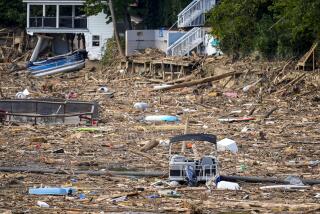Jeanne Delivers More Misery
- Share via
STUART, Fla. — Storm-weary Floridians weathered their fourth hurricane in six weeks as Jeanne lashed the Sunshine State with 120-mph winds and torrential rains Sunday that turned neighborhood streets into muddy rivers, ripped roofs from trailers and knocked out power to 2 million homes and businesses.
So far, the hurricane is responsible for at least six deaths statewide, authorities said
Jeanne pulled a looping right turn over the Atlantic Ocean just days before making landfall late Saturday at Hutchinson Island, 35 miles north of West Palm Beach -- the same area hit by Hurricane Frances three weeks ago. For several furious hours, the Category 3 hurricane brought 20-foot-high waves that pounded a wide swath of Florida’s east coast.
By 2 p.m., Jeanne had weakened to a tropical storm as it swirled west over central Florida’s lowlands, bringing 5 to 10 inches of rain to areas already saturated by previous storms. It then passed south of Orlando before swerving north toward the Florida Panhandle -- where 70,000 homes and businesses remained without power after the battering delivered by Hurricane Ivan 10 days ago.
Jeanne was expected to pass through Georgia and South Carolina today.
“This storm is a heavyweight,” said Joe Stawara, owner of the Fairlane Harbor Mobile Home Estates in nearby Vero Beach, where half the park’s 232 trailers were damaged. Many lost roofs or had holes punched through their frames by the heavy winds.
“We’ve already endured so many storms, we feel like a ... boxer in the 15th round of a fight -- it doesn’t take much to bring us down,” Stawara said. “And Jeanne definitely packed a punch.”
The hurricane, which killed 1,500 people in Haiti, also was blamed in the deaths of a Miami man electrocuted by a downed power line and a couple whose SUV plunged 40 feet into a canal south of Boca Raton. The body of another man was found floating in a Palm Bay ditch, while a 60-year-old man was found dead -- lying in water in his flooded home -- after drinking a lot of alcohol during a hurricane party, officials said. And not far from St. Augustine, a 15-year-old boy was crushed by a falling tree. More than 90 people in Florida have been killed by hurricanes since mid-August.
As residents huddled in homes and shelters, turning most central Florida communities into ghost towns, search and rescue teams in Martin and St. Lucie counties spent Sunday looking for homeowners who had decided to face the storm and had been left stranded by floodwaters.
Florida Gov. Jeb Bush had called for the evacuation of more than 2 million residents, but many -- weary after fleeing other storms -- threatened to ignore the order. By Sunday, 60,000 people, some of whose homes had been damaged by Hurricane Frances, had checked into shelters statewide.
But for some evacuees, safe harbor was hard to come by: In Melbourne, 120 people, many in wheelchairs and needing oxygen, were moved repeatedly after the roof twice blew off shelters where they were being housed. “I’m sure they were scared,” said Yvonne Martinez, a Brevard County emergency response spokeswoman. “They bused them out at the height of the storm’s fury.”
In St. Lucie County, 117,000 people were without power Sunday, and county administrator Doug Anderson announced a 6 p.m. curfew for public safety reasons. “We’re going to lock this county down tonight, because if we don’t have any power, it’s going to be very dark out there,” Anderson said.
No power meant no stop lights, and drivers were told to treat all intersections as a four-way stop. Traffic lights dangled precariously Sunday, bobbing in the strong winds that scoured the area; some cables lay on the pavement.
Officials for Florida Power & Light, which serves 35 of the state’s 67 counties, predicted that it would take days, and for some, weeks to restore power to customers spread across 22 counties.
“For some people, there’s an outside chance that it will be three weeks from now before they get their lights back on,” spokesman Bill Swank said. “Even though we knew this was coming, there’s no way we could have prevented this disaster. Nature has a mind of her own.
“We just have to wait until she’s through and then move in to clean up the mess.”
In Fort Pierce, a city of more than 35,000, residents were without water service. And so much sand was piled up by Jeanne’s storm surge on South Hutchinson Island’s major oceanfront road that it will have to be plowed and removed like snow, Anderson said.
Visiting the Treasure Coast to see Jeanne’s damage firsthand, Bush said that 3.5 million Floridians might be without power by the time the hurricane makes its way through the state. The governor said trucks were on the way north from Homestead, an Air National Guard base south of Miami, to supply Jeanne’s victims with water and ice.
“We literally have had millions of people be impacted by these storms,” Bush said during a visit to the St. Lucie County emergency operations center. “Some just with loss of power, others have lost everything. So this is unprecedented. There’s been nothing like it.”
But, Bush said, “adversity makes us stronger, and this resilient state will rebound.”
President Bush, the governor’s brother, on Sunday declared 19 Florida counties natural disaster areas as a result of Jeanne, making available special federal loans and other funding.
Jeanne is the fourth hurricane to hit Florida since Aug. 13, arriving in the wake of Charley, Frances and Ivan -- the first such storm sequence nationwide since Texas was hit by four hurricanes in 1886. And National Hurricane Center officials warned Sunday that the “mean season,” as they call it, lasts until Nov. 30th.
Chris Sisko, a meteorologist with the hurricane center in Miami, said it was “extremely rare” for two storms to make land as close to one another -- about five miles apart --as Frances and Jeanne.
In Martin County, one resident said that he had had enough of hurricanes.
“Two hurricanes within 10 miles in three weeks. I thought it was something personal,” Paul Coyle joked.
Three weeks ago, his single-story home on Sewall’s Point had its roof shingles peeled off by Frances’ winds and the false ceiling ruined by leakage. Then Saturday night, Jeanne’s storm surge inundated the 47-year-old carpenter’s house with 6 inches of dirty water.
Coyle said he felt dazed at having to engage again in hurricane cleanup and didn’t know where to start. On Sunday, he opened the windows to dry out the interior. But the back-to-back storms hadn’t dented his enthusiasm for the house, which he purchased this year. “I figure the storm streak is over,” Coyle said.
Jeanne brought Florida to a near standstill. Like the storms that preceded it, Jeanne damaged bridges, closed several Atlantic seaports, shut down theme parks such as Disney World, Universal Studios and Sea World and curtailed Amtrak service. Flights also were canceled statewide.
Michael Brown, director of the Federal Emergency Management Agency, said Sunday that the series of hurricanes had prompted the agency’s largest deployment ever -- outdoing its response for the 1994 Northridge earthquake and the Sept. 11 terrorist attacks. The hurricanes have caused parts of 10 eastern states from Vermont to Florida to be declared federal disaster areas.
Even before Jeanne, FEMA officials had received 650,000 requests for aid from hurricane victims in Florida and throughout the eastern United States and disbursed $354 million, Brown said. But Florida, he added, has presented a special case.
“These people in Florida have gotten beaten to death,” he said. “Many have been hit by one storm after the next. It’s hurt their pocketbooks and their psyches. I used to worry about hurricane amnesia. After these storms, I fear of hurricane fatigue for many of these residents.”
Jeanne has damaged more than property. Naturalists said the state’s runaway development had resulted in the paving over of wetlands and the dredging of coastal jetties that could have provided a natural buffer to the flooding and storm surge.
“This storm was the coup de grace,” said Victoria Tschinkel, Florida’s state director of the Nature Conservancy. “It caused extensive flooding and wore away beaches because there was less natural armor to protect the environment -- and that’s sad for all of us who love natural Florida.”
Dahlburg reported from Stuart and Glionna reported from Orlando.
More to Read
Sign up for Essential California
The most important California stories and recommendations in your inbox every morning.
You may occasionally receive promotional content from the Los Angeles Times.














